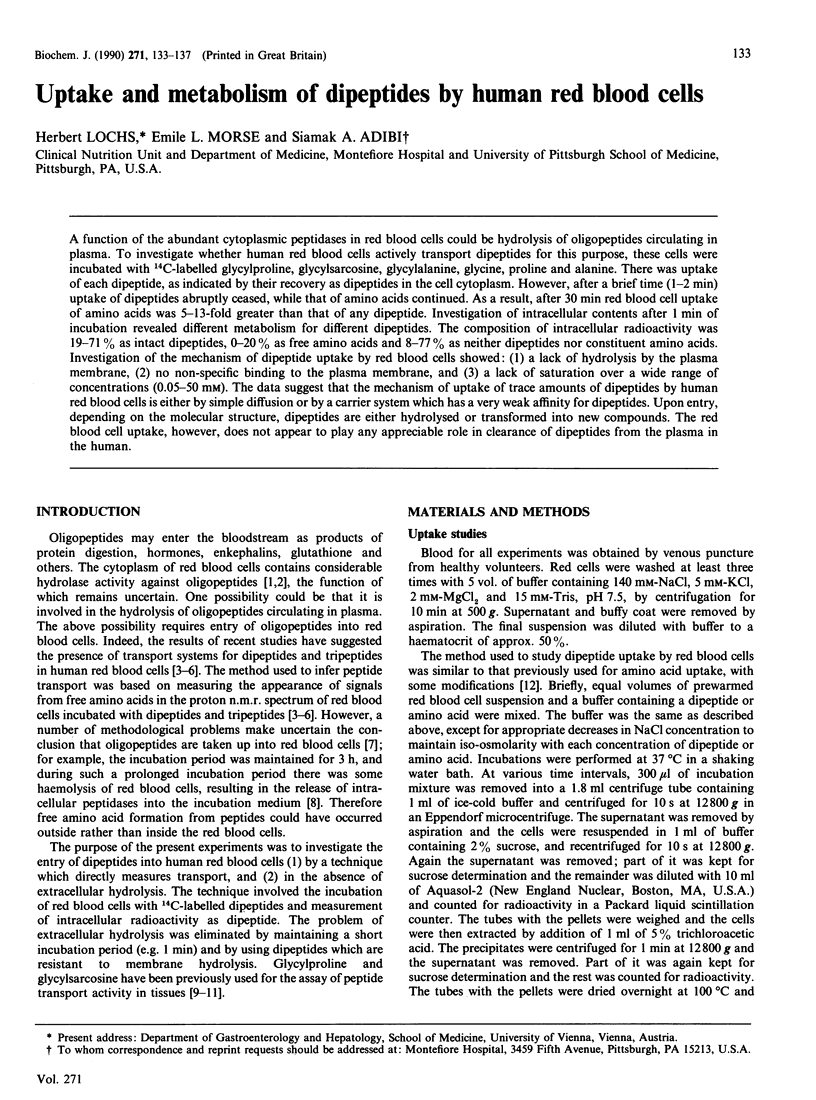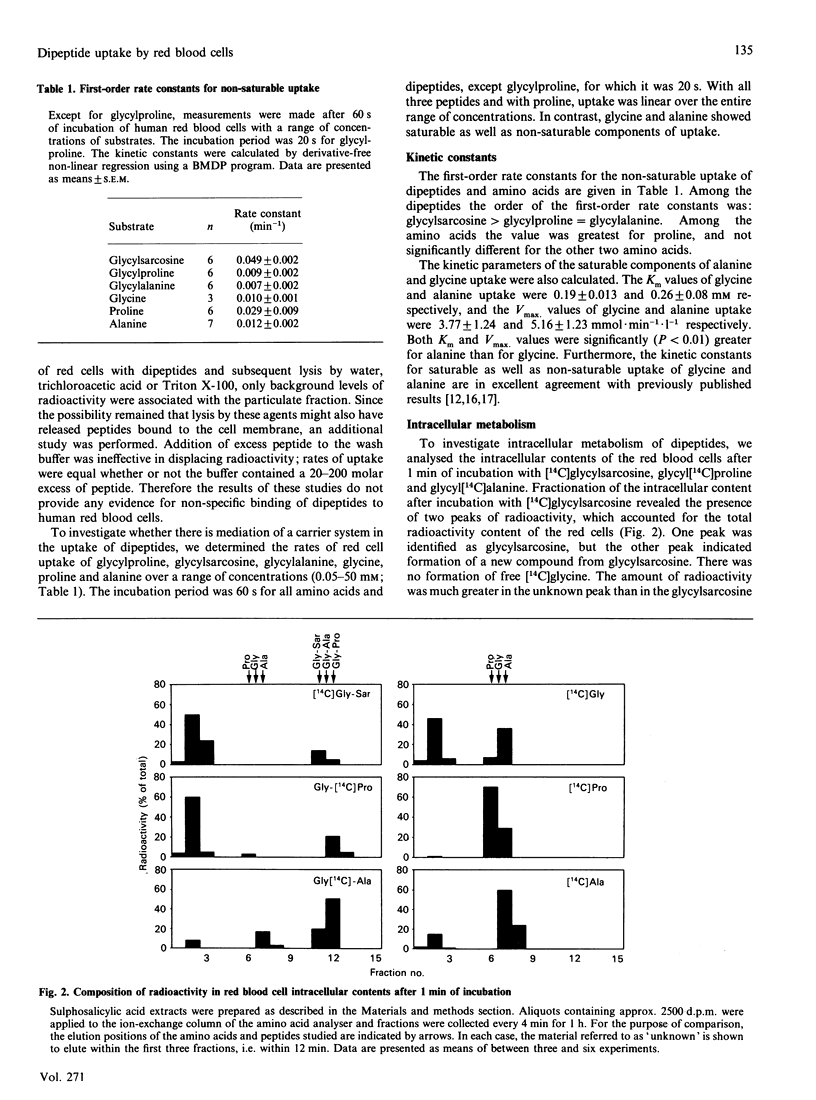Abstract
A function of the abundant cytoplasmic peptidases in red blood cells could be hydrolysis of oligopeptides circulating in plasma. To investigate whether human red blood cells actively transport dipeptides for this purpose, these cells were incubated with 14C-labelled glycylproline, glycylsarcosine, glycine, proline and alanine. There was uptake of each dipeptide, as indicated by their recovery as dipeptides in the cell cytoplasm. However, after a brief time (1-2 min) uptake of dipeptides abruptly ceased, while that of amino acids continued. As a result, after 30 min red blood cell uptake of amino acids was 5-13-fold greater than that of any dipeptide. Investigation of intracellular contents after 1 min of incubation revealed different metabolism for different dipeptides. The composition of intracellular radioactivity was 19-71% as intact dipeptides, 0-20% as free amino acids and 8-77% as neither dipeptides nor constituent amino acids. Investigation of the mechanism of dipeptide uptake by red blood cells showed: (1) a lack of hydrolysis by the plasma membrane, (2) no non-specific binding to the plasma membrane, and (3) a lack of saturation over a wide range of concentrations (0.05-50 mM). The data suggest that the mechanism of uptake of trace amounts of dipeptides by human red blood cells is either by simple diffusion or by a carrier system which has a very weak affinity for dipeptides. Upon entry, depending on the molecular structure, dipeptides are either hydrolysed or transformed into new compounds. The red blood cell uptake, however, does not appear to play any appreciable role in clearance of dipeptides from the plasma in the human.
Full text
PDF




Selected References
These references are in PubMed. This may not be the complete list of references from this article.
- ADAMS E., DAVIS N. C., SMITH E. L. Peptidases of erythrocytes. III. Tripeptidase. J Biol Chem. 1952 Dec;199(2):845–856. [PubMed] [Google Scholar]
- ADAMS E., MCFADDEN M., SMITH E. L. Peptidases of erythrocytes. I. Distribution in man and other species. J Biol Chem. 1952 Oct;198(2):663–670. [PubMed] [Google Scholar]
- Al-Saleh E. A., Wheeler K. P. Transport of neutral amino acids by human erythrocytes. Biochim Biophys Acta. 1982 Jan 22;684(2):157–171. doi: 10.1016/0005-2736(82)90001-3. [DOI] [PubMed] [Google Scholar]
- Ganapathy V., Mendicino J. F., Leibach F. H. Transport of glycyl-L-proline into intestinal and renal brush border vesicles from rabbit. J Biol Chem. 1981 Jan 10;256(1):118–124. [PubMed] [Google Scholar]
- King G. F., Kuchel P. W. A proton n.m.r. study of iminodipeptide transport and hydrolysis in the human erythrocyte. Possible physiological roles for the coupled system. Biochem J. 1984 Jun 1;220(2):553–560. doi: 10.1042/bj2200553. [DOI] [PMC free article] [PubMed] [Google Scholar]
- King G. F., Kuchel P. W. Assimilation of alpha-glutamyl-peptides by human erythrocytes. A possible means of glutamate supply for glutathione synthesis. Biochem J. 1985 May 1;227(3):833–842. doi: 10.1042/bj2270833. [DOI] [PMC free article] [PubMed] [Google Scholar]
- King G. F., York M. J., Chapman B. E., Kuchel P. W. Proton NMR spectroscopic studies of dipeptidase in human erythrocytes. Biochem Biophys Res Commun. 1983 Jan 14;110(1):305–312. doi: 10.1016/0006-291x(83)91296-2. [DOI] [PubMed] [Google Scholar]
- Kuchel P. W., King G. F., Chapman B. E. No evidence of high capacity alpha-glutamyl-dipeptide transport into human erythrocytes. Biochem J. 1987 Feb 15;242(1):311–312. doi: 10.1042/bj2420311. [DOI] [PMC free article] [PubMed] [Google Scholar]
- Lochs H., Morse E. L., Adibi S. A. Mechanism of hepatic assimilation of dipeptides. Transport versus hydrolysis. J Biol Chem. 1986 Nov 15;261(32):14976–14981. [PubMed] [Google Scholar]
- Lombardo Y. B., Morse E. L., Adibi S. A. Specificity and mechanism of influence of amino acid residues on hepatic clearance of oligopeptides. J Biol Chem. 1988 Sep 15;263(26):12920–12926. [PubMed] [Google Scholar]
- Rubino A., Field M., Shwachman H. Intestinal transport of amino acid residues of dipeptides. I. Influx of the glycine residue of glycyl-L-proline across mucosal border. J Biol Chem. 1971 Jun 10;246(11):3542–3548. [PubMed] [Google Scholar]
- Srivastava S. K., Awasthi Y. C., Miller S. P., Yoshida A., Beutler E. Studies on gamma-glutamyl transpeptidase in human and rabbit erythrocytes. Blood. 1976 Apr;47(4):645–650. [PubMed] [Google Scholar]
- Tate S. S., Meister A. Interaction of gamma-glutamyl transpeptidase with amino acids, dipeptides, and derivatives and analogs of glutathione. J Biol Chem. 1974 Dec 10;249(23):7593–7602. [PubMed] [Google Scholar]
- Taylor E., Burston D., Matthews D. M. Influx of glycylsarcosine and L-lysyl-L-lysine into hamster jejunum in vitro. Clin Sci (Lond) 1980 Mar;58(3):221–225. doi: 10.1042/cs0580221. [DOI] [PubMed] [Google Scholar]
- Vadgama J. V., Christensen H. N. Discrimination of Na+-independent transport systems L, T, and asc in erythrocytes. Na+ independence of the latter a consequence of cell maturation? J Biol Chem. 1985 Mar 10;260(5):2912–2921. [PubMed] [Google Scholar]
- Vandenberg J. I., King G. F., Kuchel P. W. The assimilation of tri- and tetrapeptides by human erythrocytes. Biochim Biophys Acta. 1985 Jul 30;846(1):127–134. doi: 10.1016/0167-4889(85)90118-1. [DOI] [PubMed] [Google Scholar]
- Young D. J., Wolowyk M. W., Fincham D. A., Cheeseman C. I., Rabenstein D. L., Ellory J. C. Conflicting evidence regarding the transport of alpha-glutamyl-dipeptides by human erythrocytes. Biochem J. 1987 Feb 15;242(1):309–311. doi: 10.1042/bj2420309. [DOI] [PMC free article] [PubMed] [Google Scholar]
- Young J. D., Wolowyk M. W., Jones S. M., Ellory J. C. Red-cell amino acid transport. Evidence for the presence of system ASC in mature human red blood cells. Biochem J. 1983 Nov 15;216(2):349–357. doi: 10.1042/bj2160349. [DOI] [PMC free article] [PubMed] [Google Scholar]


